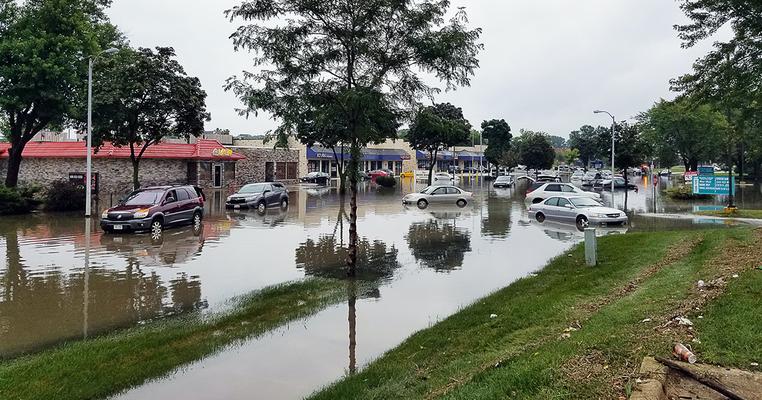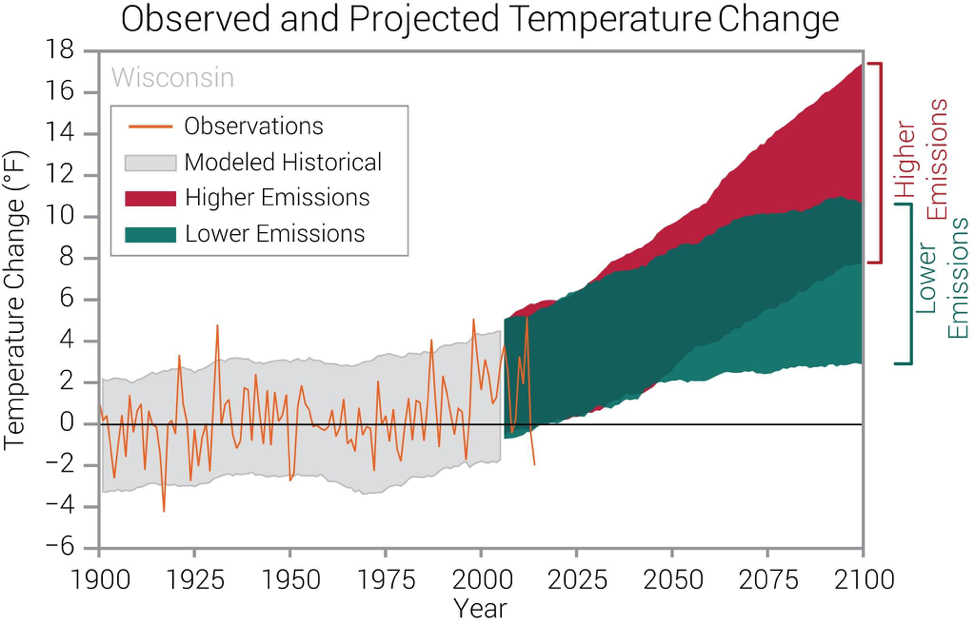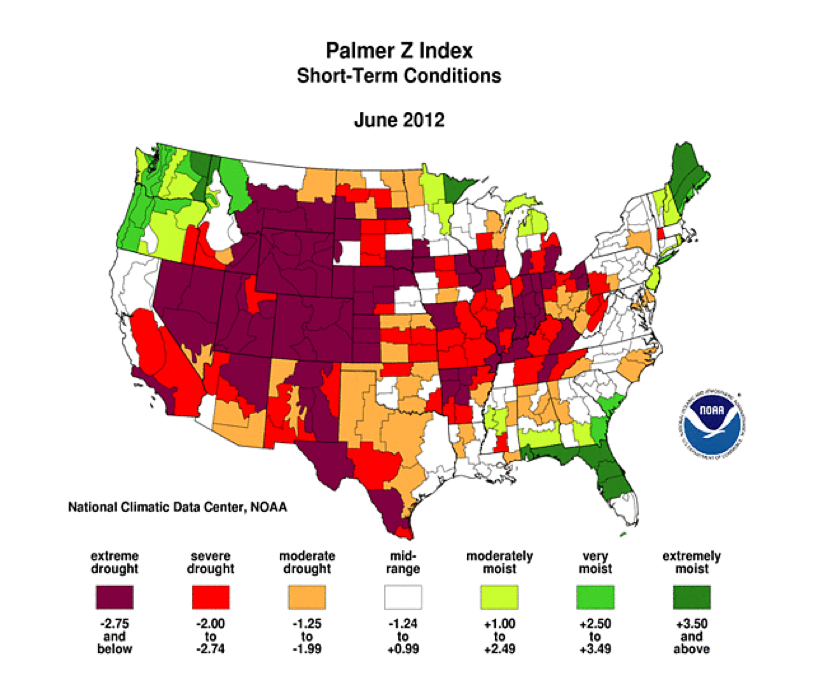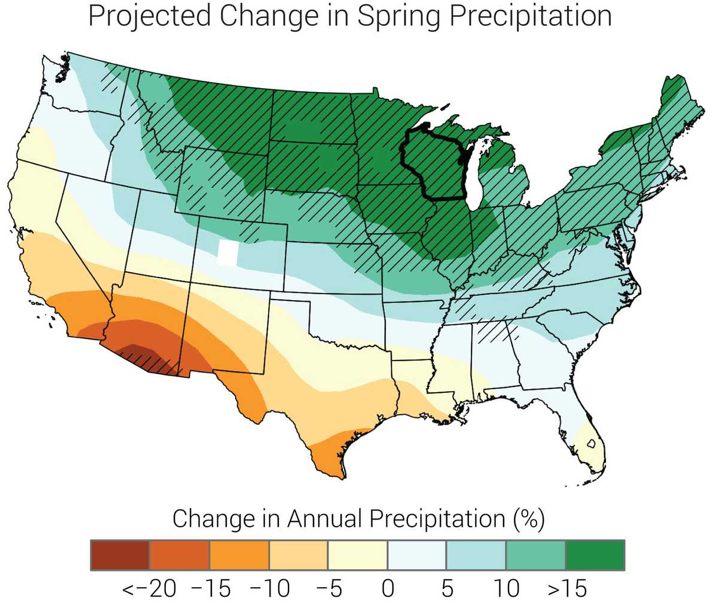
How Is the Climate Crisis Affecting Wisconsin?
You might know Wisconsin as America’s Dairyland, and for good reason, since about a quarter of our cheese and butter is made in the state. You’ve probably also visited Wisconsin (so to speak) in two different decades — the 1950s and ‘70s, respectively — while watching Happy Days and That 70s Show.
But it’s not just the Foreman family and the Fonz that call Wisconsin home — nearly six million people live there today. And the science is clear: Wisconsinites could see their state transform drastically over the coming decades without action on climate change.
Fortunately, in 2019, Governor Tony Evers signed an executive order that made Wisconsin the first state in the Midwest to commit to going 100-percent carbon free by 2050. That’s encouraging news, because the Badger State is already experiencing the impacts of the climate crisis today. Here’s how.
Rising Temperatures
Here’s the climate reality: Since the early 1900s, Wisconsin's average annual temperature has risen by about 2 degrees Fahrenheit. Without action to address the climate crisis, “historically unprecedented warming” is expected by the end of this century.

When humans burn fossil fuels, we release greenhouse gases like carbon dioxide and methane. These gases trap heat in our atmosphere, like a blanket around the planet. And while that might sound kind of cozy to say, in reality, these extra greenhouse gases are raising temperatures around the globe and throwing our once-stable climate systems out of whack.
>> Read more: What Is the Greenhouse Effect <<
Wisconsin is already 2 degrees Fahrenheit warmer, on average, than it was in the early twentieth century. And if humans don’t drastically curb our use of fossil fuels, by the end of the twenty-first century, the state could see its “hottest years being about 11 degrees Fahrenheit warmer than the hottest year in the historical record.”
That’s mind-boggling because even just a few degrees disrupt our lives. Wisconsin’s projected temperature rise puts it in truly uncharted territory.
Rising temperatures like this have big consequences, but perhaps none is more important than the impact on human health. That’s because very high heat is extremely dangerous for the human body, especially when it’s combined with spikes in humidity. Together, humidity and heat create the heat index, a measure of how hot it feels to the human body.
In fact, according to a report released in 2019 by the Union of Concerned Scientists (as reported by Wisconsin State Journal), “under the current trajectory, by 2050 Wisconsin could see two weeks per year of dangerous heat — with heat indexes above 100 degrees.”
High heat indexes can overwhelm the human body’s ability to maintain a healthy internal temperature, potentially resulting in heat stroke — which is life threatening, especially for the most vulnerable among us, such as the very young, the elderly, outdoor workers, and those with preexisting conditions.
The Union of Concerned Scientists underlines the stark reality in its report: “Failing to reduce heat-trapping emissions would lead to a staggering expansion of dangerous heat” across the US.
Drought
Here’s the climate reality: Summer droughts are a natural part of Wisconsin’s climate. But these droughts are expected to become more intense as temperatures rise with climate change.
Here’s a head scratcher: Precipitation is expected to increase across Wisconsin and the Great Lakes region over the next few decades, especially in the winter and spring. So how is it possible that the state is expected to see more extreme drought? Think about it this way: The state may not see more droughts overall, but when droughts do strike, they are expected to pack a stronger and stronger punch.
NOAA summarizes what’s going on well: “Even if precipitation increases in the future, increases in temperature will increase the rate of loss of soil moisture during dry periods.”
Another way to think about it? Climate change makes our water cycle more intense. Higher temperatures mean more water is evaporating from land into the atmosphere. This means less moisture in the soil for our crops — and when you couple that with earlier and earlier snowmelt, it can spell disaster for the people who grow our food.
>> Read more: How Is Climate Change Impacting the Water Cycle? <<
For an idea of how droughts may impact Wisconsin (and the United States) in the future, we can look back to 2012. In June of that year, the southern third of Wisconsin was classified by NOAA as in extreme drought, with many other parts of the state in moderate to severe drought conditions. By July, the US Department of Agriculture had declared 23 counties in the state as disaster areas.

It was a familiar story for many states at the time. As UCUSA wrote in July of 2012, “We’re in the midst of an epic drought, the worst drought the country has experienced in the last half century. Twenty nine states across the West, Midwest and Great Plains are experiencing drought.” The drought took an enormous toll on farms, especially on corn, soybeans, and livestock.
Without action, Wisconsin is expected to see more and more intense droughts like these, which has serious implications for food security – for Wisconsin and across the US.
Heavy Precipitation and Flooding
Here’s the climate reality: While snowfall is expected to decline in Wisconsin, scientists expect the state to see an increase in overall precipitation — which could mean more frequent and more severe flooding.
Wait, weren’t we just talking about drought? Though it might seem contradictory, climate change makes both floods and droughts more likely in many places. And Wisconsinites are expected to see that first-hand at home.
We know this: when droughts do come around, they’ll be more extreme. But overall, Wisconsin is expected to become wetter and warmer over time thanks to the climate crisis (much like neighboring Michigan). This is, in part, because warmer air holds more water vapor, leading to increased precipitation.

“Projected change in spring precipitation (%) for the middle of the 21st century compared to the late 20th century under a higher emissions pathway.” (Source: NOAA)
In fact, 2019 was the wettest year on record for the Badger State (and the rest of the Midwest). According to the Fourth National Climate Assessment, over the last 3 decades, the region has seen up to a 15 percent increase in annual precipitation compared to the first half of the twentieth century. By the end of the twenty-first century, Midwesterners could see up to a 30 percent increase in precipitation during the winter and spring.
>> Learn more: The Climate Crisis and Flooding <<
In March of 2019, much of the Midwest (including Wisconsin) also experienced devastating floods due to rapidly melting snow and heavy precipitation. Over the year, flooding throughout the Midwest cost the region a staggering $6.2 billion and took at least four lives.
Floodwaters themselves can be extremely dangerous. But they threaten our health in more ways than one: floods can mean hazardous chemicals spilling into our water supply and exposure to water-borne diseases. When we take action to solve climate change, we’re also taking action to protect our health.
Here’s What You Can Do
Here at Climate Reality, we believe in climate hope. So while that felt like a lot of bad news all at once, we want to make sure you know: We can, we must, and we will solve the climate crisis (in Wisconsin and beyond). And the best news of all? The solutions to solve it are already available today.
Get started fighting for a better tomorrow by downloading our latest (free!) e-book, What Can You Do? Your Guide to Climate Action in 2020.
Discover how you can use your voice and your choices to take climate action. Get your copy today.

